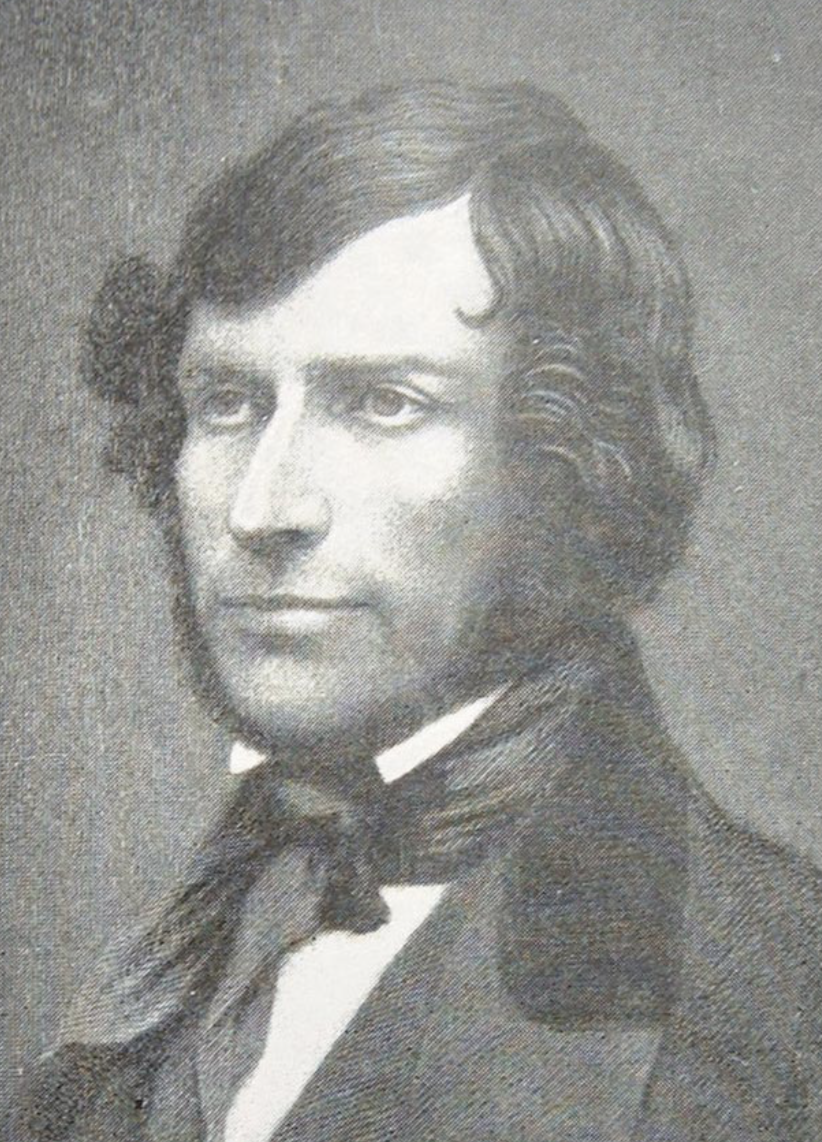November third is the 205th anniversary of the birth of John Mitchel, Irish republican and supporter of slavery.
The son of a Presbyterian minister, he was acclaimed by Pearse who declared Jail Journal to be ‘the last of the four gospels of the new testament of Irish nationality the last and the fieriest and the most sublime’. De Valera revered Mitchel and in 1943 when he imagined Ireland as ‘the home of a people who valued material wealth only as a basis for right living, of a people who, satisfied with frugal comfort, devoted their leisure to the things of the spirit’ he too was delving into Jail Journal for his inspiration.
Inflamed by the suffering he witnessed on a trip to Galway, it was Mitchel, more than any other writer or politician, who shaped the nationalist perception of the Great Famine.
He wrote: “I could see, in front of the cottages, little children leaning against a fence when the sun shone out for they could not stand, their limbs fleshless, their bodies half-naked, their faces bloated yet wrinkled, and of a pale, greenish hue…I saw Trevelyan's claw in the vitals of those children: his red tape would draw them to death: in his Government laboratory he had prepared for them the typhus poison.”
I could see, in front of the cottages, little children leaning against a fence when the sun shone out for they could not stand, their limbs fleshless, their bodies half-naked, their faces bloated yet wrinkled, and of a pale, greenish hue…I saw Trevelyan's claw in the vitals of those children: his red tape would draw them to death: in his Government laboratory he had prepared for them the typhus poison.”
In May 1848, responding to such writing, Dublin simmered, angry and ready for rebellion. Fearful of Mitchel’s power, London’s Punch magazine emphasized Mitchel’s international standing by portraying him as an Irish Monkey challenging the Great British Empire. The Times thundered against him. When John Mitchel produced his own republican newspaper, the United Irishman, it sold out. In order to silence Mitchel, to rob him of his heroic status, his possible martyrdom, the British Government passed the 1848 Treason Felony Act, which sought to treat treason as a common crime. Mitchel was arrested, tried and transported.
When Mitchel escaped from Van Diemen’s Land tens of thousands of people welcomed him to San Francisco. Likewise in 1854 when he arrived in New York there were torch-lit processions with both the city and state honours. After the American Civil War the Fenians offered him the leadership of that movement and when he visited the Irish College in Paris it was to the applause and a standing ovation from both staff and students.
He died in 1875 as an unrepentant, physical force, republican abstentionist M.P. Every major newspaper in Ireland, Britain and the USA noted his passing. Catholic clergymen led his cortege to the Presbyterian graveyard. The Freemans Journal observed, ‘A remarkable man has been removed from the stage of Irish politics…The brave man struggling with the storms of fate lived long enough for consolation if not for success.’ The unionist Irish Times declared that John Mitchel ‘descended into the grave without bringing the shadow of a stain on the fair name of his ancestors.’ Some obituaries were critical but all acknowledged his courage and devotion to Ireland.

John Mitchel in life, and after, was regarded as a major national and international figure, with a status similar to that of Wolfe Tone. Like Tone, he rejected sectarianism, tried to engage the northern Presbyterians in the Repeal Movement and freely accepted his daughters’ conversions to Catholicism. When the new, fragile Irish state uncritically accepted its heroic origins John Mitchel was personally and politically revered. Until the 1960s the name of John Mitchel was spoken in admiration on the streets of his home town and across nationalist Ireland. Football clubs and Sinn Féin Cummans were called after him. His lifelong romance with Jenny Verner, which involved war, tragedy and travel over three continents, is unrivalled in life or fiction.
Yet very few in Ireland will acknowledge his birthday on 3 November. In September 2015 the National Famine Commemoration crossed the border for the first time. It was an event of historical significance; held in Newry, the place where John Mitchel was reared, and where he is buried. Indeed the theme of the International Famine Conference, held as part of the National Famine Commemoration, was ‘John Mitchel: The Legacy of the Great Famine,’ however the conference organizers had to overcome strong objections from local council officials who thought Mitchel’s name should not be associated with the event.
Mitchel once regarded as a great nationalist and republican hero has, for some, become an embarrassment; the forgotten man in a decade of commemorations.
In contrast, in March 1965, to commemorate both the 150th anniversary of Mitchel’s birth and the approaching 50th anniversary of the 1916 Rebellion the nationalist citizens of Newry proudly erected a statue to John Mitchel. Yet even as Mitchel was being placed on a pedestal Sean Lemass was dismantling De Valera’s ‘dreary paradise’ and helping to erode Mitchel’s status as an apostle of Irish Republicanism. From the mid-twentieth century, with a growing economic confidence, with membership of the E.C.C., with a more cordial and productive relationship with Britain and a greater measure of political stability in the north, John Mitchel suffered from a revision of his own and the State’s heroic narrative. A truncated republic, minus six counties, embracing change and welcoming investment, even from Britain, was not an Ireland Mitchel would have been comfortable with. As the Northern Ireland peace process progressed, as republican Ireland sought an accommodation with Britain, increasingly, nationalist Ireland became unsettled by Mitchel’s singular physical force solution, by his hatred of Britain. Politically and economically Mitchel’s Irish pater familias who ‘aspired to no lot but labour in his own land…never troubling his mind about the progress of the species not knowing in the least what that phrase means’ was becoming an irrelevance. People no longer saw contentment in stagnation.
John Mitchel was no Wolfe Tone. He rejected the Enlightenment. In a speech to the University of Virginia in 1854 he had claimed there was no such thing as progress and other than seeking humane treatment for the lowly, which might include flogging, his ferocious political pen had little interest in the Rights of Man. Yet being out of synch with progress is not sufficient explanation for very few having marked the 200th anniversary of Mitchel’s birth.
John Mitchel supported not only slavery, but also, the reopening of the African Slave trade. He made many public pronouncements of his support for slavery but in a private letter to Mary Thompson of Ravensdale, outside Dundalk, he approached the question, which puzzles modern Ireland. How could the champion of the Irish peasant during the Great Famine, support slavery for the black man?
He wrote: ‘Be perfectly assured as I am that you (and the majority of the civilized 19th Century world) are altogether wrong on the whole question, and I absolutely right on it…and when any of your taunting friends ask you (as you say they do) “What do you think of Ireland’s emancipation now? Would you like an Irish Republic with an accompaniment of slave plantations?” – just answer quite simply – Yes, very much. At least I would answer so.’
From the early to mid-20th century this was not sufficient reason for nationalist Ireland to reject John Mitchel. Arthur Griffith, in his 1914 preface to Jail Journal wrote. ‘Even his views on negro-slavery have been deprecatingly excused, as if excuse were needed for an Irish Nationalist declining to hold the negro his peer in right’. He continued, ‘When the Irish Nation needs explanation or apology for John Mitchel the Irish Nation will need its shroud.’
Now in the 21st Century, with the Confederate Battle Flag being lowered in disgrace in the southern states, belatedly, the dark stain of his prejudice is seeping through the legacy of John Mitchel, obscuring his influence on the birth and early development of the Irish State. The apparent contradiction, to the modern mind, of John Mitchel writing passionately in support of both the Irish peasantry and slavery is, perhaps, due to John Mitchel’s admiration of classical Greece and Rome and a society of patricians, plebeians, and slaves. On board ship and sailing into exile John Mitchel not only enjoyed the comforts of a gentlemanly (Patrician) status, drinking the Captain’s best wine, but he also despised ‘the brutal obscenity and stupid blasphemy’ of his fellow convicts. He did not wish to be ‘buried in their unblessed company.’ For John Mitchel society was inert. The peasant was a peasant who deserved better land tenure but he would remain a peasant. The slave deserved humane treatment (which might include the lash) but he would remain a slave. When, in desperation as the war ended the Confederate Congress suggested arming the slave Mitchel was appalled.
He wrote: ‘If it be true that the state of slavery keeps these people depressed below the condition to which they could develop their nature their intelligence, and their capacity for enjoyment, and what we call “progress,” then every hour of their bondage for generations is a black stain on the white race.’
If it be true that the state of slavery keeps these people depressed below the condition to which they could develop their nature their intelligence, and their capacity for enjoyment, and what we call “progress,” then every hour of their bondage for generations is a black stain on the white race.’
Given that he had lost two sons fighting for the Confederate lost cause, 18-year-old Willie at Gettysburg and 26-year-old Captain C. Mitchel as commander of Fort Sumter, John Michel could not accept that the slave was capable of fighting in a disciplined army. The slave was a slave because he was not capable of being free.
John Mitchel was a remarkable man, a remarkably flawed man. His views on slavery mean that he is the forgotten hero Irish Nationalism. Yet, in his day he was a national and international figure, admired by friend and feared by foe. His writing and actions were commented upon over three continents. He stoically accepted his exile and the suffering of his family for the cause of Ireland. In 1848, it was he who declared that he hoped to see the tricolour ‘as our national banner, over a forest of Irish pikes…’.
In the 19th Century, with first Young Ireland and then with the Fenians, he was a much more significant figure than Jeremiah O’Donovan Rossa. Both Pearse and De Valera greatly admired him. Yet, today he is republicanism’s flawed and forgotten hero. Mitchel’s wish that the tricolour should become the national banner of Ireland was fulfilled after 1916; but it is another flag, the Confederate battle flag that shrouded two of his sons; a flag that divided people according to race, that has defined his legacy.
Anthony Russell is the author of Merrion Press’s ‘Between Two Flags: John Mitchel and Jenny Verner’ and co-editor of IAP’s ‘John Mitchel Ulster and the Great Famine’. He was the prime mover in bringing the 2015 National Famine Commemoration to Newry and was co-director of the associated International Famine Conference ‘John Mitchel: The Legacy of the Great Famine.’ He is the author of ‘The Trial of P. H. Pearse before the Court of History’ and ‘The Trial of James Craig before the Court of History’, both of which have played across Ireland and Canada and both of which feature John Mitchel as a lawyer. He is the Director of the exhibition: ‘D’Arcy McGee: Irish Rebel – Canadian Patriot’ in Carlingford.





